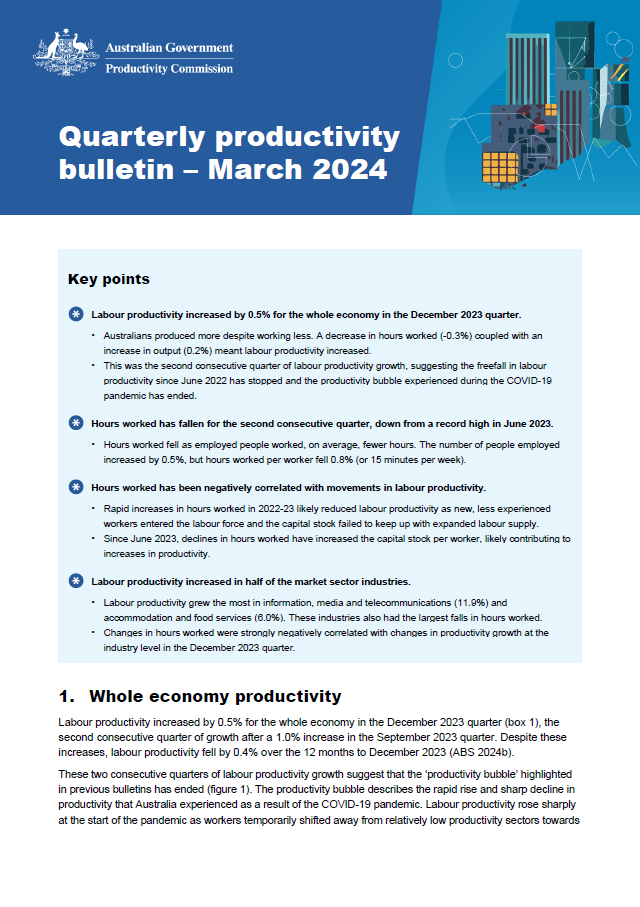Quarterly productivity bulletin – March 2024

PC productivity insights
Released 27 / 03 / 2024
This Bulletin unpacks the Australian Bureau of Statistics (ABS) March 2024 quarterly productivity statistics release and examines trends and new developments underlying Australia’s productivity performance.
Labour productivity rose for the second consecutive quarter as hours worked declined from historical highs, following the end of a bubble in productivity growth during the COVID-19 pandemic.
Productivity bulletin: green shoots mark end of productivity bubble
Labour productivity increased for the second quarter in a row in the December 2023 quarter, suggesting a return to ‘productivity normal’ after the effects of the COVID-19 pandemic.
The March Productivity Bulletin finds labour productivity increased by 0.5% in the December quarter, as hours worked fell by 0.3% while output increased by 0.2%.
“For two quarters in a row Australians produced more while working fewer hours. And while monthly labour force data is volatile, we can now say with a bit more confidence that the freefall in labour productivity that began in June 2022 has likely bottomed out,” said Deputy Chair Alex Robson.
Despite the recent quarterly data, labour productivity still fell by 0.4% over the 12 months to December 2023.
“The sharp decline in productivity since June 2022 was due mostly to the end of the COVID-19 ‘productivity bubble’. Labour productivity rose significantly at the start of the pandemic, as workers temporarily moved from relatively low productivity sectors towards high productivity sectors, before declining as lockdown restrictions eased,” said Deputy Chair Robson.
Employed people working fewer hours drove the overall decline in hours worked in the December quarter. The number of people employed increased by 0.5% and hours worked per worker fell by 0.8%, or roughly 15 minutes per week.
“Labour demand has been historically high in recent years, which has seen an influx of newer, less experienced workers into the workforce. This has likely put temporary downward pressure on labour productivity growth, as new workers require time to learn and upskill,” said Deputy Chair Robson.
“The increase in hours worked also led to a record decline in the capital-labour ratio in 2022-23, as increases in the capital stock, the tools and resources workers need to be productive, did not keep pace.”
Labour productivity increased in half of the market sector industries, predominantly due to decreases in hours worked rather than increases in output. Labour productivity grew the most in information, media and telecommunications (11.9%) and accommodation and food services (6.0%). These industries also had the largest falls in hours worked.
“There are positive signs in this data, but productivity still sits just above the average from 2015 to 2019. Governments will need to continue advancing productivity enhancing reforms to see these green shoots flourish into more meaningful productivity growth.”
Media requests
Media team – 02 6240 3330 / media@pc.gov.au
- Labour productivity increased by 0.5% for the whole economy in the December 2023 quarter.
- Australians produced more despite working less. A decrease in hours worked (-0.3%) coupled with an increase in output (0.2%) meant labour productivity increased.
- This was the second consecutive quarter of labour productivity growth, suggesting the freefall in labour productivity since June 2022 has stopped and the productivity bubble experienced during the COVID-19 pandemic has ended.
- Hours worked has fallen for the second consecutive quarter, down from a record high in June 2023.
- Hours worked fell as employed people worked, on average, fewer hours. The number of people employed increased by 0.5%, but hours worked per worker fell 0.8% (or 15 minutes per week).
- Hours worked has been negatively correlated with movements in labour productivity.
- Rapid increases in hours worked in 2022-23 likely reduced labour productivity as new, less experienced workers entered the labour force and the capital stock failed to keep up with expanded labour supply.
- Since June 2023, declines in hours worked have increased the capital stock per worker, likely contributing to increases in productivity.
- Labour productivity increased in half of the market sector industries.
- Labour productivity grew the most in information, media and telecommunications (11.9%) and accommodation and food services (6.0%). These industries also had the largest falls in hours worked.
- Changes in hours worked were strongly negatively correlated with changes in productivity growth at the industry level in the December 2023 quarter.
Media requests
Media team – 02 6240 3330 / media@pc.gov.au
Bulletin – March 2024
- Key points
- 1. Whole economy productivity
- 2. Industry level productivity
- References
- Copyright and publication detail
Appendix: Supporting data
- A primer on productivity
- Detailed productivity statistics
- Productivity data revisions
We value your comments about this publication and encourage you to provide feedback


